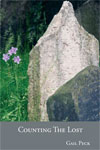Jeanne Marie Beaumont - Impr ...
John Bradley - The Art of Sl ...
William Lusk Coppage - The C ...
Kyle Gray - Through the Fenc ...
Kathleen Hellen - On the Wes ...
Tyler King - Sustain
Lynne Knight - Dog Is Your C ...
Bonnie Wai-Lee Kwong - The R ...
George Looney - The Eternal ...
Sarah Maclay - 49
Marilyn Ringer - The Off-Han ...
George Wallace - bridget

The poems in this collection which are responses to wartime photographs are the most memorable and horrifying as they depict actual people who probably died shortly after their images were captured. Peck’s stark portrayals give a human face to the war as these photographs could be of any child we might see out on the playground or holding his/her mother’s hand in a store. |
|
|
 Counting the Lost
Counting the Lost

